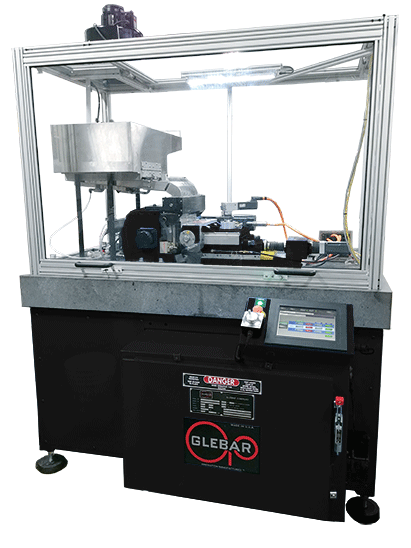Glebar’s Applications Division conducts research and development of innovative cutoff and grinding technology. Their most recent focus was to innovate the existing design of our PG-9 series of Centerless Plunge Grinding Machines. The goal was to help customers reduce setup times, increase throughput, and maintain tighter tolerances.
Current Process: Lathes and Hydraulic Form Grinders
In order to shape spherical and cylindrical parts, manufacturers rely on lathes and hydraulically powered form grinders.
Challenges: Complicated Setup, Inconsistent and Slow Process, Manual Operation, and Open Work Environment
Lathes form parts from bar stock one at a time limiting throughput. The setup for a lathe is complicated and labor-intensive requiring a skilled technician. The cutting process relies on a skilled operator working the different gears and levers to bring the cutting tool closer or further from the part affecting the tolerance. With several manually controlled parts, the setup and cutting processes are difficult to replicate, creating inconsistent surface finishes. The open, high-speed cutting environment and manual operation increase the potential of operator injury.
While hydraulically powered form grinders can produce multiple parts per cycle, they too rely on skilled technicians for setup. Several microswitches must be configured to set the grinding sequence. As the hydraulic system warms up, the speed of the regulating wheel fluctuates, making it difficult to control the tolerances. The grinding cell of most hydraulic form grinders is exposed, raising the risk of potential operator injury.
Solution
Solution: Glebar PG-912DG Enclosed Centerless Form Grinder Featuring 12” Wide Work Wheel and Servo Motors
Solution achieved! The result is Glebar’s new PG-912DG Enclosed Centerless Form Grinder. Using a 12” wide work wheel and servo motors, it is designed to reduce setup times, increase throughput, and maintain tighter tolerances. Our engineers didn’t stop there- adding an enclosed design, a simple touch-screen HMI, and remote connectivity and data collection. Combined, these functions help to generate more uptime and produce higher quality parts, something every manufacturer strives to attain.
Benefits: Increase Throughput, Reduce Setup Times, Achieve Tighter Tolerances, and Provide Safer Working Conditions
In testing, Glebar’s engineers were able to increase throughput by as much as 30%.
To complete the grinding cell, we paired the 12” wide work wheel with a 9” oscillating regulating wheel powered by servo motors, creating greater repeatability in the grind and maintaining a tighter tolerance. It can be positioned using the touchscreen HMI to finite positions, improving the accuracy, sphericity, and repeatability of the grind. When an operator selects a job, the servo motors automatically adjust to programmed positions, reducing setup time. In testing, our engineers achieved a Cpk two times greater than the existing process. Our technicians develop and customize the HMI to the application allowing operators to run multiple Glebar high precision plunge grinders concurrently.
In this specific application, a stainless-steel hopper automatically drops parts into the feeder channeling them into singular stations on the plunge grinder. Within a 14 second cycle, up to 12” of parts can be ground simultaneously. The servo-powered oscillating regulating wheel assembly rotates the balls randomly improving sphericity. Helping to maintain a high-quality part, the granite machine bed provides enhanced rigidity, as well as thermal and vibratory stability.
Operator safety and a clean work area are crucial in today’s manufacturing environment. The PG-912DG features an enclosed design with interlocks as well as a mist collector. The interlocks prevent opening the enclosure while the grinder is running.
Data reporting and analysis are essential in 21st-century manufacturing. The high-speed multi-axis control system can expand the machine functionality and includes the ability to remotely diagnose the machine and gather production data for reporting. The PG-912DG can also interface with Glebar Advanced Analytics, our cloud-based solution that allows operators and managers to remotely receive actionable real-time analytics on easy-to-read dashboards. Decisions can be made using the data to reduce downtime, boost capacity, increase machine availability, and more.
Glebar’s Form Grinders are designed to grind parts as small as 0.050” to 4” diameter on the same machine. These grinders can shape any spherical or cylindrical component into unlimited forms on a large variety of materials such as rubber, plastics, carbon fiber, Teflon (PTFE), and various metals. A multitude of applications can be served, including insulators for electronic components, fuse bodies, crystal quartz glass boules for fiber optics, check valves for pumps and valves, golf balls, and other consumer products.
12″ wide work wheel increases throughput
Servo motors, touch screen HMI provide finite positioning
Achieve tighter tolerances, repeatability
Enclosed design, interlocks provide safe working environment
Remote diagnosis, data collection

Explore | PG-912DG Form Grinding Machines

PG-912DG
The PG-912DG Enclosed Centerless Form Grinder is designed to increase throughput, reduce setup times, and achieve tighter tolerances. Additionally, it provides better integration to gauges, automation, and remote service diagnostics. It can produce multiple cylindrical or spherical parts from a single piece of material.



